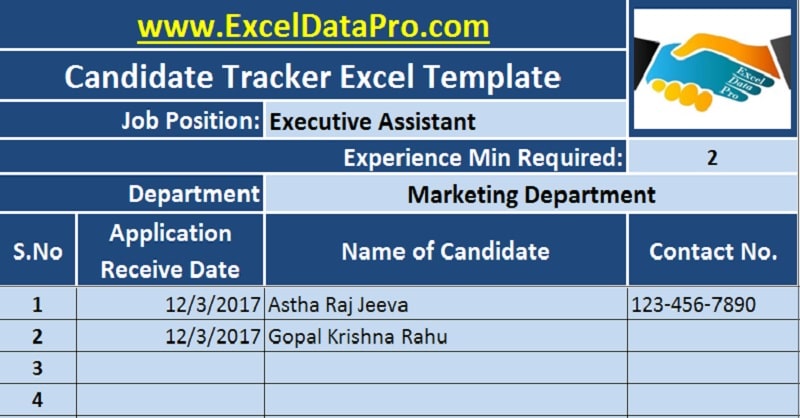
Job Candidate Tracker is a ready-to-use template in Excel, Google Sheets, OpenOffice Calc, and Mac Numbers that helps you track your recruitment process.
Job Candidate Tracker easily stores data of job applicants and further helps to track and scrutinize applicants efficiently. Usually, HR requires workforce management during the recruitment process. They need to micromanage everything from receiving applications until the hiring of employees.
Table of Contents
Process of Recruitment
The recruitment process differs from company to company. Usually, every recruitment process consists of the following 5 steps: receiving applications, sorting, screening interviews, issuing offers, and joining.
Receiving Applications
The recruitment process starts with receiving applications for the approved post. An organization receives applications through multiple sources such as recruitment agencies, direct applications, internal employees, etc.
Defining the sources during the application process helps to know the effectiveness of sources of application.
Sorting of Applications
Usually, the number of application that a company receives are high in numbers. You need to sort these applications based on different criteria such as minimum experience, qualification, etc.
The scrutinizing of applications eliminates unwanted applications and provides useful CVs according to the given criteria.
Interviewing Applicants
The third process is the interviewing process. If the job profile is general there is only one interview. Usually, corporate companies use multiple interviewing to finalize their candidates. This process also eliminates non-suitable candidates.
The interviewing process for technical job posts requires additional interviews. These additional interviews help the recruiters to know the practical skills of the candidates.
Issuing Offer
After interviewing the candidates, the recruiter issues offer to the selected candidate. Candidates have the right to accept or decline the offer. An offer should be according to the industry standards.
Sometimes, a company needs to offer higher compensation to attract good talent. This also helps to attract competitor’s candidates that bring customer database with them.
Joining of Candidate
As soon as the candidate accepts the offer, the process of joining takes place. Sometimes the candidates can join immediately and sometimes they need to notify their previous employer. Generally, the job market has 1-2 months of the notice period.
In case of relocation from another city, the candidate requires time for joining the company. The employee provides a tentative date of joining. The job post can be considered filled only when the candidate joins the company. Preference is given to immediate joining as it decreases the time to fill the position.
Job Candidate Tracker Template
We have created a Job Candidate Tracker Excel Template to easily manage and track your recruitment process. The template consists of predefined formulas and functions. Hence, it simplifies the process of scrutinizing and screening, interviewing, and joining of the candidates.
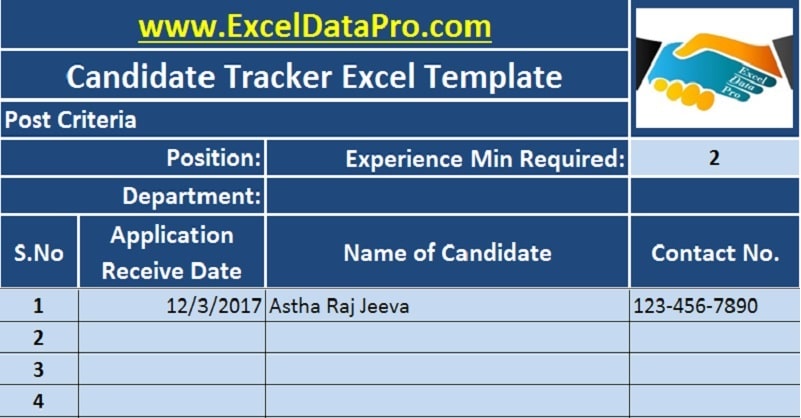
This template can be useful for HR assistants, HR professionals, and other business entities to efficiently and effectively manage the recruitment process.
This template is available in 4 file formats – Excel, Google Sheets, Open Office Calc, and Apple Numbers. Click on the button below to download the desired format:
Excel Google Sheets Open Office Calc Apple Numbers
Click here to Download All HR & Payroll Excel Templates for ₹299.
Note: To edit and customize the Google Sheet, save the file on your Google Drive by using the “Make a Copy” option from the File menu.
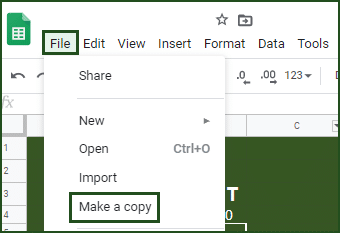
Additionally, you can download other HR templates like Salary Breakup Report Excel Template, Gratuity Calculator (India) Excel Template, Taxable Gratuity Calculator Excel Template, and Employee Training Log Excel Template from our website.
Let us discuss the contents of the template in detail.
Contents of Job Candidate Tracker Template
This template consists of 3 sections: Header Section, Applicants Details Section, and Interview Process Section
Header Section
The header section consists of the company name, company logo, and heading of the sheet ” Job Candidate Tracker.
Additionally, it consists of Job position criteria like job position, department, and minimum experience.

When you define the minimum experience for the job position it will ease the initial scrutinizing process. We will discuss it later in the article.
Applicants Detail Section
Initial 10 columns of the sheet below the header contain the applicant’s data as given below:
Sr. No: Serial number of the applicant.
Application Receive Date: Enter the date on which you have received the application.
Name of Candidate: Name of the applicant for the required job posting.

Contact No.: Contact number of the applicant.
Consultant: Enter the consultant name if the applicant has come through any hiring agency/consultant.
Previous Organization: The name of the company where the applicant currently works or the last worked company.
Experience in Yrs: Applicant’s years of experience relevant to the job posting.
Division: Division in which the applicant currently performs his duty.
Application Status: This cell consists of a predefined logical formula to simplify your process of scrutinizing.
An IF statement has been used here. This automatically rejects the application if the years of experience are below the required years. It will display “Rejected” in the cell.
The formula used here is =IF(G7=””, “”, IF(G7<$D$4, “Rejected”, “”)).
Remarks: The first remark section is for recommendations from the scrutinizer.
Interview Process Section
The interview process section consists of 3 step interview process.
1st Interview section consists of subheadings like date of interview, the name of interviewer, applicant’s status, and remarks from the interviewer.
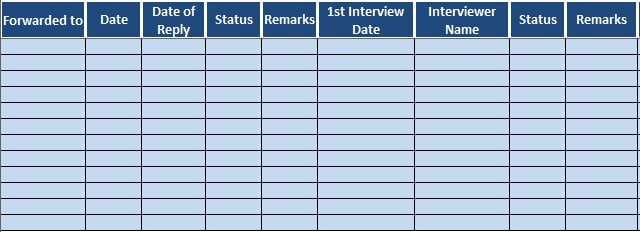
The applicant status consists of the drop-down list for approved, rejected, and on hold. Select a relevant item from the drop-down menu. Click here to learn how to create easily create a drop-down list.
Similarly, the columns for the second interview are also made. The final interview section consists of additional sections as follows:
- Finalized CTC
- Level
- Offer status
- Remarks
- Tentative DOJ (date of joining)
- Actual DOJ (date of joining).

Recruitment Metrics
Recruitment metrics are measures that help you to track and analyze the effectiveness of the hiring success. It also helps to optimize the hiring process as and when required for the best return on investment.
In other words, the metrics for measuring the effectiveness and efficiency of the recruiting process are called Recruitment Metrics. Currently, these metrics are an essential part of a data-driven hiring and recruitment analytics.
Important Recruitment Metrics
Here are 8 important recruiting measures that you must use to track your hiring process. Let us understand the purpose of each in brief.
Time To Hire
Time To Hire is days from the opening of a position and signing of a job contract by the candidate. It is used to evaluate the efficiency of the recruitment process. It also provides insights into which job position takes more time to hire.
Click here for more information on Time Hire(TTH) along with a ready-to-use Time To Hire Calculator.
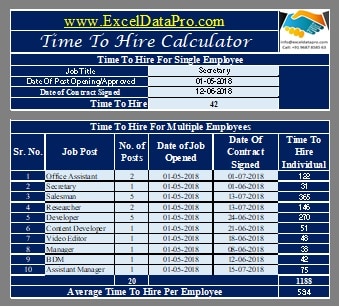
Time To Fill
Time To Fill (TTF) is an HR metric similar to Time To Hire. The difference between the date of the job post opening and the date of an employee joining the organization is Time to Fill. Time to hire considers the days until the candidate signs the contract.
Click on the link to understand Time To Fill in along with a ready-to-use Time To Fill Calculator.

Cost Per Hire
Cost Per Hire or CPH is the total expenses a company incurs for recruiting new staff. It includes starting from the job post advertising to the joining of an employee.
Professionals use this to measure the effectiveness of the recruiting process. Low CPH is advisable while recruiting without compromising the quality of recruits.
It varies depending on the size of the organization, recruitment channels you use and the seniority of the position, etc.
Click here for more information on the Cost Per Hire along with a ready-to-use Cost Per Hire Calculator.

Post Occupancy Rate
Post-occupancy is the total number of occupied posts for which a candidate is hired but not joined the organization. It is the percentage of posts occupied against the total number of approved posts. Here the total number of approved posts is the sum of filled/occupied in addition to the vacant posts.
Click here for more information on Post Occupancy Rate along with a ready-to-use Post Occupancy Rate Calculator.
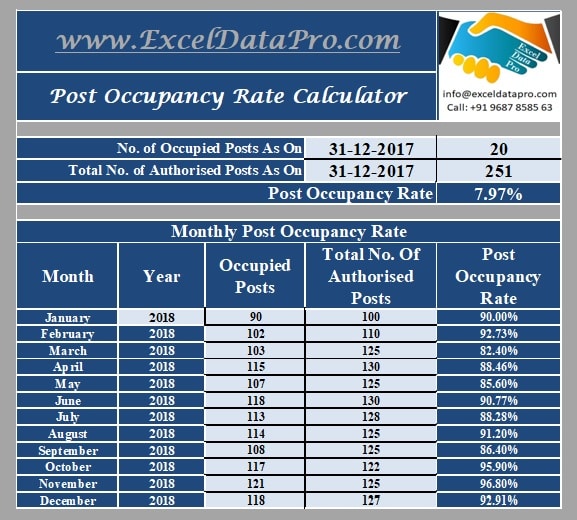
Job Vacancy Rate
A Job Vacancy means the number of unfilled or empty posts for which a company is actively indulged in the recruiting process. These include advertisements, interviewing, etc from outside the company.
It is the percentage of empty posts against the total number of approved posts at a specific time. The total number of approved posts includes the total of posts (post occupied + vacant) at the end of a specific period.
Click here for more information on the Job Vacancy Rate along with a ready-to-use Job Vacancy Rate Calculator.
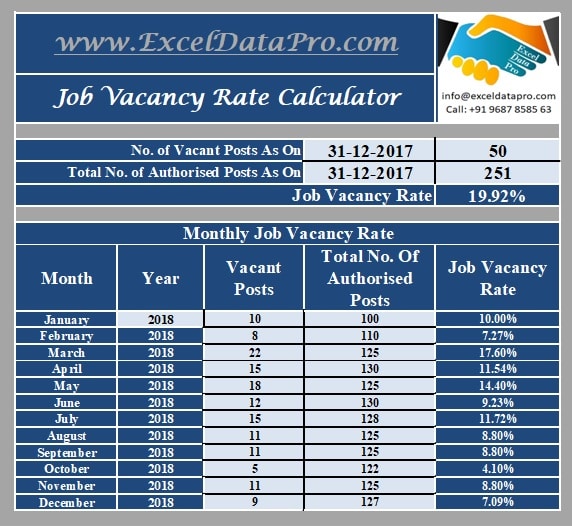
Offer Acceptance Rate
The Offer Acceptance Rate measures the acceptability of your job offers. It also measures the efficiency of your recruitment process. It provides insights into how attractive is the job offer for the vacant position to applicants.
This metric is useful when and where there are competitive talent markets. The details you require to calculate the offer acceptance rate are:
- Number of Job Offers accepted by the candidates.
- The total number of job offers issued.
Click here for more information on the Offer Acceptance Rate along with a ready-to-use Offer Acceptance Rate Calculator.
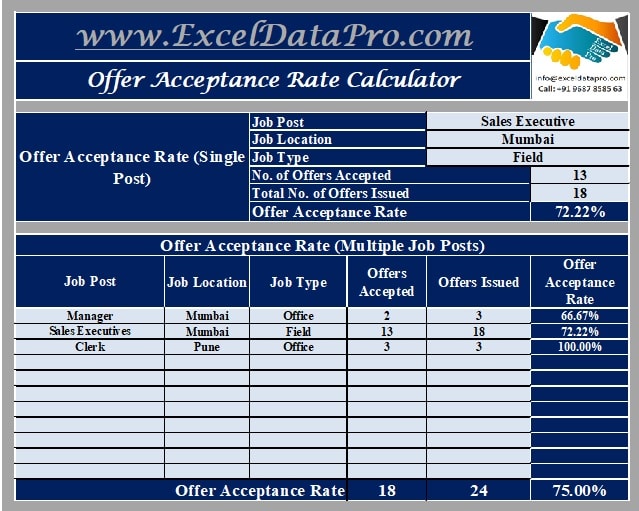
Offer Decline Rate
Offer Decline Rate provides the percentage of offers refused by the candidates for a particular post. It gives an insight into your recruiting process and knowing the possible reason for the decline.
The reason for the decline can be better offers, work environment, better benefits, company reputation, etc. A company needs to know what is the actual cause of denial.
A recruiter must get the real answers from the declining candidates. “Accepted another offer” cannot be the only reason in reports for not accepting your offer.
Click here for more information on the Offer Decline Rate along with a ready-to-use Offer Decline Rate Calculator.
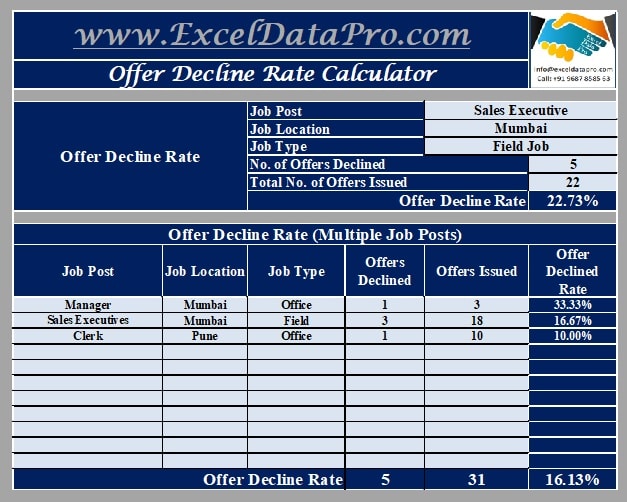
New Hire Turnover Rate
The new hire turnover rate is the percentage of employees leaving the organization during the first year. Lower New Hire Turnover Rate indicates the effectiveness of your recruitment process.
When the newly recruited staff stays with the company for longer periods helps you lower recruitment cost.
In other words, it is the percentage of newly recruited employees leaving against the total number of new hires. According to an industry study, the normal new hire turnover rate is 20%.
Click here for more information on the Offer Decline Rate along with a ready-to-use Offer Decline Rate Calculator.
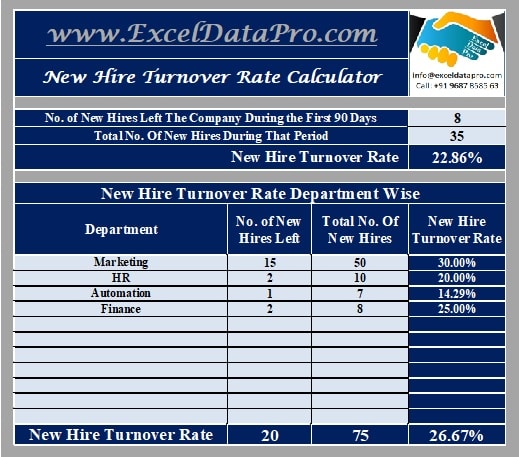
Benefits of Using Recruitment Metrics
- It gives you insight into how, when, and what is happening during the recruitment process.
- These metrics help in making the right recruiting decisions.
- Proper use of these metrics and changes in the hiring process helps to increase Human Capital Return on Investment.
- They help in identifying the malpractices and loops carried out by hiring agencies or HR officials.
- It also helps you to take the necessary changes in the hiring process.
- It helps to identify the best source providing the right type of candidate for the post.
We thank our readers for liking, sharing, and following us on different social media platforms.
If you have any queries please share in the comment section below. I will be more than happy to assist you.
Frequently Asked Questions
What is the recruitment process in HR?
The recruitment process refers to using the potential resources for filling up the vacant positions. The recruitment process starts with identifying the job vacancy and analyzing job requirements. Furthermore, it adds to reviewing, screening, shortlisting the applications to select the right candidate.
What is a good recruitment process?
A good recruitment process allows you to find qualified candidates quickly and efficiently. The process requires planning as well as constant evaluation.
What is the recruitment life cycle?
The recruitment life cycle refers to the complete process of recruitment. It consists of 6 main recruiting stages. These stages include:
- Preparing
- Sourcing
- Screening
- Selecting
- Hiring
- Onboarding
How to identify hiring needs?
For a newly formed or just vacated job post, we cannot find the perfect talent if we don’t know what we need. Thus, a recruiter has to identify the vacancies by analyzing the job specifications. This includes analyzation of knowledge, skills, and experience that are required for the role.
Which factors influence the recruitment process?
These five factors influence the recruitment process:
- Size of the Company.
- Compensation Structure.
- Work Environment.
- Company’s Growth Rate
- State of employment in the economy.